
A centimetre or centimeter is a unit of length in the metric system, equal to one hundredth of a metre, centi being the SI prefix for a factor of 1/100. The centimetre was the base unit of length in the now deprecated centimetre–gram–second (CGS) system of units.

In gymnastics, the floor is a specially prepared exercise surface, which is considered an apparatus. It is used by both male and female gymnasts. The event in gymnastics performed on floor is called floor exercise. The English abbreviation for the event in gymnastics scoring is FX.

The cubit is an ancient unit of length based on the distance from the elbow to the middle finger. It's primarily associated with the Sumerians, Egyptians and Israelites. "Cubits" is found in the Bible re: Noah's Ark, Ark of the Covenant, Tabernacle, Solomon's Temple. The common cubit was divided into 6 palms × 4 fingers = 24 digits. Royal cubits added a palm for 7 palms × 4 fingers = 28 digits. These lengths typically ranged between 444 and 529.2 mm, with an ancient Roman cubit being as long as 120 cm (47 in).

The pommel horse is an artistic gymnastics apparatus. Traditionally, it is used by only male gymnasts. Originally made of a metal frame with a wooden body and a leather cover, the modern pommel horse has a metal body covered with foam rubber and leather, with plastic handles.

Parallel bars are floor apparatus consisting of two wooden bars slightly over 11 feet (340 cm) long and positioned at roughly hand height. Parallel bars are used in artistic gymnastics and also for physical therapy and home exercise. Gymnasts may optionally wear grips when performing a routine on the parallel bars, although this is uncommon.
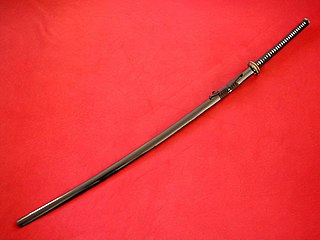
The ōdachi (大太刀) or nodachi is a type of traditionally made Japanese sword used by the samurai class of feudal Japan. The Chinese equivalent of this type of sword in terms of weight and length is the miao dao, and the Western battlefield equivalent is the longsword or claymore.

An obi (帯) is a belt of varying size and shape worn with both traditional Japanese clothing and uniforms for Japanese martial arts styles. Originating as a simple thin belt in Heian period Japan, the obi developed over time into a belt with a number of different varieties, with a number of different sizes and proportions, lengths, and methods of tying. The obi, which once did not differ significantly in appearance between men and women, also developed into a greater variety of styles for women than for men.

Bombax ceiba, like other trees of the genus Bombax, is commonly known as cotton tree. More specifically, it is sometimes known as Malabar silk-cotton tree; red silk-cotton; red cotton tree; or ambiguously as silk-cotton or kapok, both of which may also refer to Ceiba pentandra.

Jeholosaurus is a genus of ornithischian dinosaur from the Early Cretaceous Period. It is thought to have been a herbivorous small ornithopod.
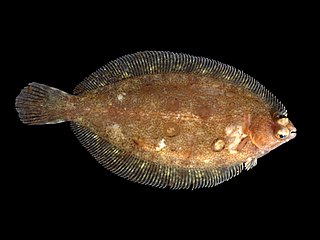
The lemon sole is a flatfish of the family Pleuronectidae. It is native to shallow seas around Northern Europe, where it lives on stony bottoms down to depths of about 200 metres (660 ft). It grows up to 65 centimetres (26 in) in length and reaches about 3 kilograms (6.6 lb) in weight.
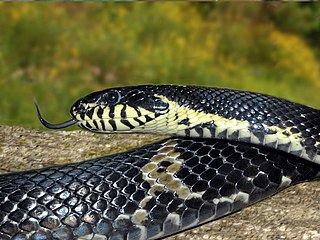
Elaphe schrenckii is a species of nonvenomous snake in the family Colubridae. The species is indigenous to Northeast Asia.
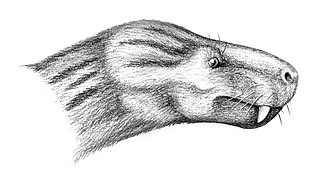
Charassognathus is an extinct genus of Late Permian cynodonts. Described in 2007 from a locality near Fraserburg, South Africa, Charassognathus is one of the earliest and most basal cynodonts. It is known only from the holotype, which dates from the Late Permian Period. The type and only species is C. gracilis. The holotype, found in the Tropidostoma Assemblage Zone of the Teekloof Formation, is made up of a crushed skull, partial lower jaw and one leg.

The Burmese ferret-badger, also known as the large-toothed ferret-badger, is a mustelid native to Southeast Asia.

Pseudopleuronectes is a genus of righteye flounders mostly native to the northwestern Pacific Ocean with one species found in the northwestern Atlantic Ocean.

The cubic metre or cubic meter is the SI derived unit of volume. Its SI symbol is m3. It is the volume of a cube with edges one metre in length. An alternative name, which allowed a different usage with metric prefixes, was the stère, still sometimes used for dry measure. Another alternative name, no longer widely used, was the kilolitre.
The yellow striped flounder, Pseudopleuronectes herzensteini, is a flatfish of the family Pleuronectidae. It is a demersal saltwater fish that occurs in the temperate waters of the northwestern Pacific, from the Sea of Japan to the Kuril Islands, Sakhalin, Korea, the Yellow Sea, Gulf of Bohai and the East China Sea. It can grow up to 50 centimetres (20 in) in length, though commonly it reaches around 28.5 centimetres (11.2 in); its maximum recorded weight is 1.3 kilograms (2.9 lb) and its maximum reported lifespan is 15 years.

The marbled flounder, Pseudopleuronectes yokohamae, is a flatfish of the family Pleuronectidae. It is a demersal fish that lives on saltwater sand and mud bottoms. Its natural habitat is the temperate coastal waters of the northwestern Pacific, from southern Hokkaido, Japan, to the Yellow Sea, Gulf of Bohai, East China Sea and Korean Peninsula. It can grow up to 45 centimetres (18 in) in length, and its maximum recorded weight is 1.9 kilograms (4.2 lb).
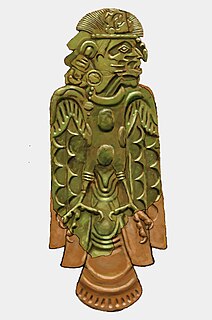
The Wulfing cache, or Malden plates, are eight Mississippian copper plates crafted by peoples of the Mississippian culture. They were discovered in Dunklin County, Missouri in 1906 by Ray Grooms, a farmer, while plowing a field south of Malden. The repousséd copper plates were instrumental to archaeologists' developing the concept known as the Southeastern Ceremonial Complex.

The blue whale has the largest penis in the animal kingdom. It is commonly cited as having an average penis length of 2.5 metres to 3 metres (9.8 ft) and a diameter of 30 centimetres (12 in) to 36 centimetres (14 in).

Hakea nitida, commonly called the frog hakea or shining hakea, is a shrub of the family Proteaceae and is endemic to an area in the southern Wheatbelt, Great Southern and Goldfields-Esperance regions of Western Australia.


















